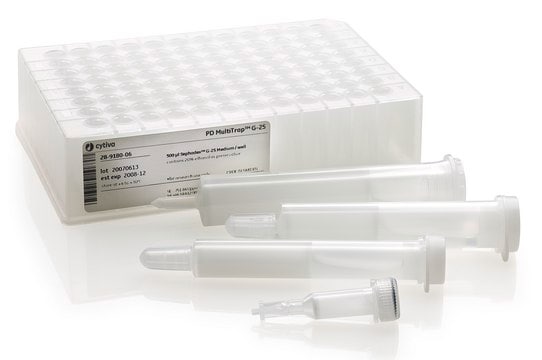SAB4600023
Anti-Mouse IgG (H+L), CF™ 405S antibody produced in goat
~2 mg/mL, affinity isolated antibody
About This Item
Productos recomendados
biological source
goat
Quality Level
conjugate
CF™ 405S conjugate
antibody form
affinity isolated antibody
antibody product type
secondary antibodies
clone
polyclonal
form
buffered aqueous solution
species reactivity
mouse
concentration
~2 mg/mL
technique(s)
flow cytometry: 1-10 μg/mL
immunocytochemistry: suitable
immunohistochemistry: suitable
indirect immunofluorescence: 1-10 μg/mL
fluorescence
λex 404 nm; λem 431 nm
shipped in
dry ice
storage temp.
−20°C
target post-translational modification
unmodified
Categorías relacionadas
General description
CF™ dyes are a series of highly water-soluble fluorescent dyes, with wavelength extended over the visible and near-infrared (IR) spectrum for labelling biomolecules, mainly proteins and nucleic acids. Primary structure of the CF™ dyes is either cyanine dyes or rhodamine dyes. CF™405S is a blue fluorescent and pH-insensitive dye, with molecular weight of ~1,169 and has an excitation laser line at 405nm and an absorption/emission maxima at 404/431nm.
Specificity
Immunogen
Features and Benefits
Physical form
Preparation Note
Legal Information
Disclaimer
¿No encuentra el producto adecuado?
Pruebe nuestro Herramienta de selección de productos.
Storage Class
10 - Combustible liquids
wgk_germany
WGK 2
flash_point_f
Not applicable
flash_point_c
Not applicable
Elija entre una de las versiones más recientes:
Certificados de análisis (COA)
¿No ve la versión correcta?
Si necesita una versión concreta, puede buscar un certificado específico por el número de lote.
¿Ya tiene este producto?
Encuentre la documentación para los productos que ha comprado recientemente en la Biblioteca de documentos.
Global Trade Item Number
| Número de referencia del producto (SKU) | GTIN |
|---|---|
| SAB4600023-250UL | 4061837589706 |
| SAB4600023-50UL | 4061837589713 |
Nuestro equipo de científicos tiene experiencia en todas las áreas de investigación: Ciencias de la vida, Ciencia de los materiales, Síntesis química, Cromatografía, Analítica y muchas otras.
Póngase en contacto con el Servicio técnico




